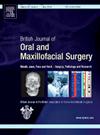Craniofacial defect rehabilitation: long-term outcomes of implant-retained ear, nasal, and orbital prostheses – the Morriston experience
IF 1.9
4区 医学
Q3 DENTISTRY, ORAL SURGERY & MEDICINE
British Journal of Oral & Maxillofacial Surgery
Pub Date : 2025-06-19
DOI:10.1016/j.bjoms.2025.06.001
引用次数: 0
Abstract
This retrospective study assessed the long-term outcomes of extraoral craniofacial implants used to support auricular, nasal, and orbital prosthesis in 138 patients treated at Morriston Hospital, Swansea, from 2004 to 2024. A total of 346 implants were reviewed, showing an overall implant survival rate of 91.9% and prosthesis survival rate of 89.6%. Long-term survival rates at 5, 10, and 20 years were highest for ear implants (100%, 90%, and 80%), respectively, followed by nasal (95.2%, 91.8%, and 91.8%) and orbital implants (89%, 86.6%, and 77%), respectively. Radiotherapy was associated with poorer implant survival, with a survival rate of 89.3% in irradiated implants compared with 97% in non-irradiated implants (p = 0.0219). Amongst the irradiated implants, those placed during ablative surgery showed a significantly improved survival rate (92.49%) than those placed following radiotherapy (68.42%, p = 0.0069). Emerging plating systems such as Epitek show promise in providing alternative nasal prosthesis retention but require further long-term follow up. The above findings underscore the necessity for careful planning alongside experienced lab technicians to optimise implant placement and enhance the long-term success of craniofacial prosthesis.
颅面缺损康复:种植体保留耳、鼻、眶假体的长期疗效- Morriston经验。
本回顾性研究评估了2004年至2024年在斯旺西Morriston医院治疗的138例患者使用口外颅面植入物支持耳、鼻和眶假体的长期疗效。共回顾了346个种植体,总体种植体存活率为91.9%,假体存活率为89.6%。耳种植体5年、10年和20年的长期生存率最高(分别为100%、90%和80%),其次是鼻种植体(95.2%、91.8%和91.8%)和眶种植体(89%、86.6%和77%)。放疗与较差的种植体存活率相关,放疗种植体的存活率为89.3%,而未放疗种植体的存活率为97% (p = 0.0219)。在放疗组中,消融手术中放置的种植体生存率(92.49%)明显高于放疗后放置的种植体(68.42%,p = 0.0069)。新兴的电镀系统如Epitek显示出提供替代鼻假体保留的希望,但需要进一步的长期随访。上述研究结果强调了精心规划的必要性,以及经验丰富的实验室技术人员,以优化种植体的放置,提高颅面假体的长期成功。
本文章由计算机程序翻译,如有差异,请以英文原文为准。
求助全文
约1分钟内获得全文
求助全文
来源期刊
CiteScore
3.60
自引率
16.70%
发文量
256
审稿时长
6 months
期刊介绍:
Journal of the British Association of Oral and Maxillofacial Surgeons:
• Leading articles on all aspects of surgery in the oro-facial and head and neck region
• One of the largest circulations of any international journal in this field
• Dedicated to enhancing surgical expertise.

 求助内容:
求助内容: 应助结果提醒方式:
应助结果提醒方式:


